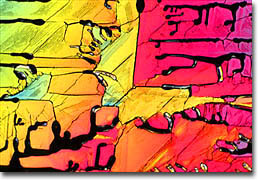The Vitamin Collection

Vitamin C
Vitamins (Vital Amines)
Like Vitamins? Check out our new Vitamins Collection.The term vitamin derives from experiments conducted early in the twentieth century, which indicated that proper nutrition was dependent upon introduction of one or several nitrogen-containing amines into the diet. Considered vital to life, these amines were dubbed "vitamines" by Polish scientist Casimir Funk, and the term was soon applied to all organic molecules that are essential to metabolism in living organisms. When it was later realized, however, that not all of these organic molecules contain amines, the letter "e" was dropped from the word, which was already in widespread use. Vitamins serve essentially the same role in all forms of life, but higher organisms have lost the ability to synthesize the molecules (or to synthesize them in adequate amounts) and must consume them in small quantities in the diet. This necessity has come to be included as part of the presiding definition of a vitamin, and many molecules that are necessary for proper health and were once considered vitamins, are no longer classed as such since they may be synthesized in sufficient quantities by the body. 
Vitamin E There are two major groups of vitamins: the fat-soluble vitamins designated by the letters A, D, E, and K, and the water-soluble vitamins which include vitamin C and the group of molecules referred to as the vitamin B complex. Members of both groups are absorbed in the human body through the intestines, but the fat-soluble vitamins are transported to other areas via the lymph system while water-soluble vitamins are conveyed to tissues via the circulatory system. Storage of the vitamins also differs, fat-soluble varieties remaining in the body for longer periods of time since the molecules may be stored in the liver, in fat, and, in some cases, organs of the reproductive system. Water-soluble vitamins, however, are only stored in the body in trace amounts, and it is, therefore, not believed to be beneficial to consume excessive amounts of the substances. Indeed, most of the surplus of a water-soluble vitamin exits the body in urine, resulting in the need of consuming the same vitamin on a daily basis in order to maintain sufficient quantities. 
Biotin (Vitamin H) Vitamins, which may be consumed from a wide range of sources, are important to the human body in a variety of ways. One of the main roles of vitamins is to act as enzymes, or coenzymes that work with other metabolic enzymes, to catalyze and aid in the completion of biochemical reactions. The specific reactions involved, however, are vitamin dependent, each molecule being associated with certain kinds of activities. Vitamin B1, for instance, is associated with the metabolism of carbohydrates, fats, and proteins, while vitamin B12 is believed to facilitate red blood cell production in humans and other higher animals. Some of the other aspects of health that vitamins are concerned in include the formation of proteins crucial for blood clotting (vitamin K), inhibition of oxidation in body tissues (vitamin E), and the production of collagen (vitamin C). 
Folic Acid A lack of proper amounts of vitamins in the diet leads to a host of vitamin-deficiency diseases. The photomicrograph in our banner depicts crystallites of vitamin C, also known as ascorbic acid, which serves as a general reducing agent in many biochemical reactions and has been implicated by Nobel laureate Linus Pauling as a cure for the common cold. More importantly, this vitamin is necessary to ward off the disease known as scurvy, which is characterized by pronounced weakness, spongy gums, bleeding mucous membranes, and spotting of the skin caused by extravasation of blood. Awareness that the consumption of citrus fruits, which are rich in vitamin C, could ward off scurvy developed during the eighteenth century, more than a hundred years before the vitamin itself was identified. This early awareness improved the lives of many sufferers of the condition and led to the regular rations of lime juice provided for sailors of the British Royal Navy that resulted in their being dubbed "limeys." Additional well-known diseases associated with vitamin deficiency include rickets (vitamin D), beriberi (vitamin B1), pellagra (vitamin B3), and pernicious anemia (vitamin B12), among others. 
beta-Carotene Typically, a normal, well-balanced diet is sufficient in meeting all of the human body's requirements for vitamins. To help ensure that consumers know exactly how balanced their food choices are, a number of different reference guides have been developed. The most familiar in the United States is the Recommended Dietary Allowance (RDA), a guideline issued by the Food and Nutrition Board of the National Academy of Sciences. RDAs may be different depending upon age and gender. A similar, but more recently developed, guideline is the Reference Daily Intake (RDI), which provides a population-adjusted average RDA based on all ages and sex groups of RDA values. Another way of expressing vitamin recommendations is through Daily Reference Values (DRV), a loose consumer guide for labeling purposes that relates suggested amounts of certain substances that a 2000-calorie diet should contain. Also frequently found on labels is the Percent of Daily Value, which relates the percentage of the total daily requirement of a vitamin or other substance provided by a single serving of the food in question. |
© 1995-2025 by Michael W. Davidson and The Florida State University. All Rights Reserved. No images, graphics, software, scripts, or applets may be reproduced or used in any manner without permission from the copyright holders. Use of this website means you agree to all of the Legal Terms and Conditions set forth by the owners.
This website is maintained by our
|